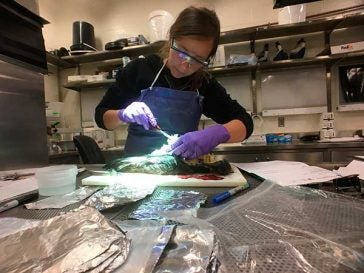
STEEP trainee Anna Robuck, PhD candidate in Dr. Rainer Lohmann’s lab at the University of Rhode Island, published a paper last month in Environmental Science and Technology analyzing PFAS in the livers of seabirds form offshore Massachusetts, coastal Rhode Island and North Carolina. The three sites were chosen to represent birds from: (i) an urban area where PFAS exposure is common (Narragansett Bay, RI), (ii) an offshore area with birds that seldom approach land (Massachusetts Bay), and (iii) an area downstream of a major PFAS producer (Cape Fear, NC). An important discovery was that one type of PFAS — perfluorooctanesulfonic acid or PFOS — was the most dominant PFAS compound in birds from all three sites. PFOS has not been produced in the United States since the early 2000s, which illustrates how persistent these chemicals are in the environment and how they can remain in tissue for many years.
Another important finding was that birds hatched downstream from the PFAS production site in North Carolina contained several of the novel PFAS compounds that have been created in recent years to replace those that have been phased out (such as PFOS). This study marks the first detection of these novel compounds in liver tissue. Even more surprising was that the same novel PFAS compounds were found in birds from Rhode Island and Massachusetts Bay, which have no connection to Cape Fear or a PFAS production plant. “It suggests that these replacement compounds are highly persistent and capable of migrating further in the environment than we were aware of. There also may be more sources of the compounds than we know about,” said Robuck.
Additionally, the same levels of PFAS were found in both the offshore birds and those living onshore. Robuck had expected the offshore birds would have lower PFAS concentrations, since they are further from contamination sources. Her findings, however, suggest that even the most remote habitats face exposure to these compounds. Robuck also found that as PFAS levels increased in the birds, the phospholipid levels in their liver decreased. This finding is especially concerning because fats are important for reproductive health, migration, and young rearing, and prompts further investigation into the relationship of PFAS and fats in wildlife populations. Robuck’s next study will analyze the PFAS concentrations in other tissues from the same birds, and she hopes the resulting data will be included in future government assessments of the impact of PFAS in wildlife and the environment.

